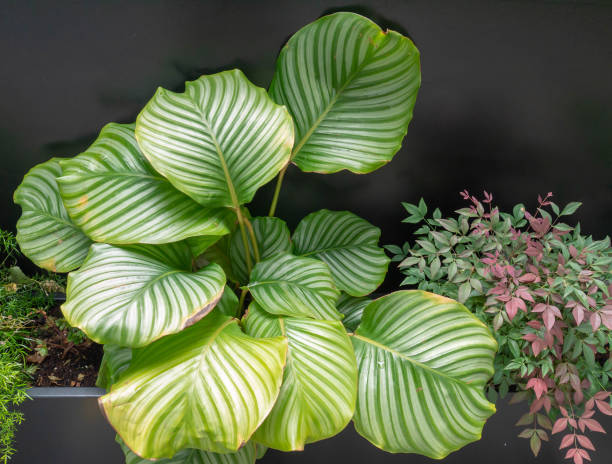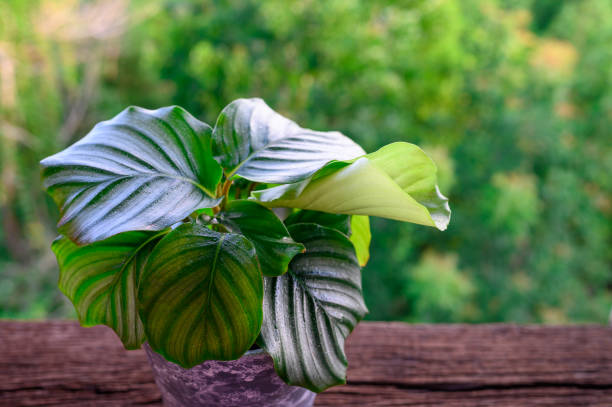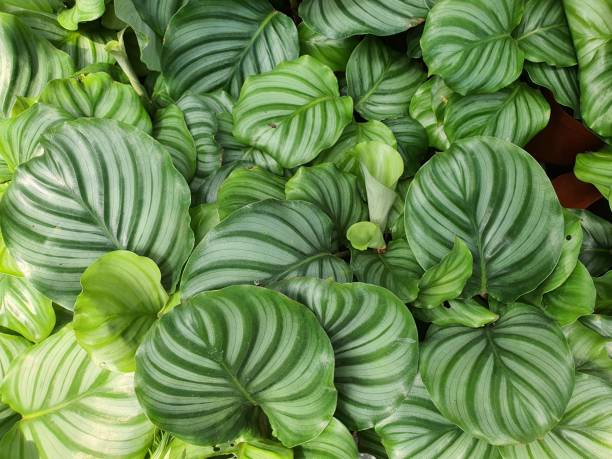
Calathea orbifoliais a popular houseplant with large, striped foliage. Although stunning, this plant has some unique care requirements and is therefore best suited to slightly more seasoned indoor plant keepers.
This comprehensive Calathea orbifolia care and growing guide are perfect if you’re new to gardening or want to expand your indoor jungle.
Table of Contents
About Calathea Orbifolia
If you enjoy the jungle vibes of other tropical plants (like Alocasia “Polly” and other Alocasia varieties) or prayer plants in general (like Maranta, Ctenanthe, and Stromanthe, whose leaves also fold up at night), a Calathea orbifolia plant is a lovely and exotic option.
The name of the plant is somewhat confusing though, as many species in the genus Calathea were reclassified in the late 20th century. Calathea orbifolia is now classified as Goeppertia orbifolia, though the original classification is still the most common name for the plant and what you’ll find it labeled as in most nurseries and plant shops.
Calathea orbifolia is one of the largest species of prayer plant, reaching heights of up to 3 feet and 2 feet, with each leaf reaching a maximum width of 12 inches. The plant is growing at a moderate rate and will experience winter dormancy.
The striking leaves of Orbifolia prayer plants have an oval shape, are broad, and have a mainly green base with lighter green or silvery streaks. These streaks look particularly distinctive because they have the same patterns as a candy cane.
Calathea Orbifolia Care Guide
Light and Temperature
Calathea orbifolia prefers these soft lighting conditions in your home because it lives in the undergrowth of a forest in its natural habitat. The plant prefers to be in a bright room without exposure to direct sunlight, so it’ll happily live in a kitchen, bathroom, or bedroom where it gets indirect light and isn’t too close to a window. Direct sunlight is too harsh on the plant and could scorch the leaves. It can also cause it to dry out too quickly.
Most homes will have no trouble keeping their plant happy as long as the ambient room temperature is comfortable and constant.
Calathea orbifolia likes temperatures between 65°F and 75°F. It’ll let you know if it isn’t enjoying the temperature in your home, however. If the leaves start to droop, the temperature is too low. When the leaves begin to curl, the air is too warm.
Try to keep your Calathea orbifolia away from drafts, A/C units, radiators, heating vents, and fireplaces. Sudden changes in temperature are bad for plants because they can cause leaf deterioration, leaf loss, and other stress-related symptoms.
Water and Humidity
Calathea orbifolia prefers to stay moist but not soggy, and it can survive with less water rather than too much.
Depending on its moisture level, I generally advise watering your orbifolia prayer plant once per week. By inserting your finger about an inch into the soil, you can determine whether your Calathea orbifolia needs to be watered. Give the soil some water if it feels dry, but don’t add more until you can see clear drainage at the bottom of the pot.
While you’ll probably end up watering your Calathea orbifolia once per week in the summer, you can cut that time down to once every two to three weeks in the cooler months while the plant is dormant.
Since Calathea orbifolia is a native of Bolivia’s tropical rainforests, it has higher-than-average humidity needs, which are typical for this kind of plant. It thrives in environments with a minimum of 50% to 60% humidity. Unfortunately, the average humidity in a house is usually lower than 50%, making the prayer plant unsuitable.
To maintain proper humidity, I recommend running a room humidifier nearby, keeping your plant in the bathroom where it benefits from the naturally warm and humid environment, or lightly misting your Calathea orbifolia every day. In addition to helping to simulate the humidity in a rainforest, misting the leaves will keep them shiny and dust-free.
If you have other similar houseplants, you can group them together to create a more humid microclimate in your home. This is an excellent way to display all of your other prayer or jungle plants while keeping things a little lower maintenance for you.

Soil and Planting
Calathea orbifolia requires well-draining soil that is kept moist but not excessively so, as do the majority of tropical houseplants. Making (or purchasing) your own peat-based potting soil will help you reach the ideal soil pH of around 6.5.
To aid in proper drainage and ensure that my plant grows to its full potential, I like to mix equal parts of potting soil, a moisture-retentive component (such as peat moss, sphagnum moss, or coco coir), and a drainage-encouraging component (such as perlite, pumice, or orchid bark).
Use a pot with drainage holes in the bottom and stay away from terra cotta ones (unless you have a tendency to overwater). Because terra cotta is a porous substance, the soil dries out far too quickly.
Fertilizing
Calathea orbifolias aren’t particularly hungry plants, so you shouldn’t worry too much about fertilizing them unless you want them to grow very quickly. The growth season, which is typically between spring and summer, is the ideal time to fertilize an orbifolia prayer plant.
A liquid houseplant fertilizer with low potassium and high nitrogen levels can be used once a month to feed your plant in order to increase the size and vibrancy of its leaves.
There’s no need to feed your Calathea orbifolia during winter, as this is when the plant goes into its dormant state. This could cause the plant’s roots to burn and eventually kill it.
Likewise, avoid fertilizing a plant that isn’t doing well; instead, try to identify the cause of the issue (such as inadequate watering, light, or humidity) and tend to it until it recovers. (Below, I’ll go into more detail about typical Calathea orbifolia issues and solutions.) Basically, if you’re in doubt about when to fertilize your Calathea orbifolia—don’t. All indoor plants are susceptible to the common and challenging issue of overfertilizing.
Pruning
Calathea orbifolias don’t need to be pruned frequently throughout the year, unless absolutely necessary. If the plant appears to be too bushy, extra leaves or aerial shoots can be removed with a sharp knife or pair of scissors, but this is a matter of taste.
In order to prevent the plant from needlessly wasting nutrients on parts of the plant that cannot be saved, you should remove any damaged, dry, or yellow leaves. The fall and winter are not the best times to prune Calathea orbifolia. The plant needs all of its nutrients at this point because it is either entering or already in its dormant stage.
Dividing Or Repotting
When its size outgrows the space you’ve given it, Calathea orbifolia, one of the biggest prayer plant species, is a likely candidate for division. Simple removal and separate potting of the offshoots will allow the mother plant to remain in its original pot from early spring to early summer. We will go over how to do this in the section on propagation that follows.
In any case, you should repot your Calathea orbifolia when the roots begin to stick out of the drainage holes. Find a larger pot (just one size larger; it doesn’t like being in a pot that’s too large) and fill it with new, well-draining soil. Depending on the plant’s growth, I advise repotting it about every two years. To keep your plant healthy if you decide against repotting it, you should provide it with new potting soil every two years.
If your Calathea orbifolia is repotted, you might notice that it seems unhappy, but this is normal. It should begin to perk back up in a few days if you just keep giving it the proper amount of water (not too much nor too little). If the plant appears to be healthy, even if it doesn’t produce any new growth for a few months, leave it alone.

Troubleshooting Calathea Orbifolia Problems
Calathea orbifolia is susceptible to some common issues, just like any other indoor plant, but in most cases, these issues can be avoided by taking preventative measures.
Root Rot
Root rot is, by far, the most serious issue that Calathea orbifolia faces and is an unfortunate frequent issue. Root rot is a disease that occurs when the plant has been overwatered, which essentially drowns the roots and kills them off. Without treatment, the rot can invade the plant itself and spread among the roots. By extension, root rot is frequently fatal.
The best way to cure root rot is to make sure you’re not overwatering your plant. While Calathea orbifolia prefers a moist environment, it will do better in slightly dry and underwatered soil than in waterlogged soil.
Always do the “finger test” (or use a moisture meter like this one) to check that the first inch of soil is completely dry before watering the plant. Before watering once more, check to see if any extra water is freely draining out of the bottom of the pot.
It’s not always easy to tell if your plant is suffering from root rot until it’s almost too late. The best time to check for root rot is when you repot the plant because you can see the roots clearly without any soil in the way.
Rotted roots, which are brown and mushy, can be cut off with a knife or pair of scissors. You should also repot the plant in fresh potting soil that’s amended with perlite, pumice, or orchid bark to help with drainage.
Clogged Pores
Calathea orbifolia is prone to developing clogged pores as a result of dust accumulation because of the size of its leaves.
Dust can clog pores and prevent a plant from effectively absorbing enough sunlight, in addition to dulling the appearance of the plant. Although it won’t have an impact on the overall health of your plant, I advise wiping the leaves with a clean, slightly damp cloth once a month on both sides.
Pests
Pests like spider mites and aphids, which feed on the sap from the leaves of Calathea orbifolia plants, are frequently found on these plants. Without treatment, these pests may cause holes or discoloration in the plant, which could compromise its general health.
Spraying them with insecticidal soap, which is simple to make at home, is the best way to get rid of aphids and spider mites. Make sure to test just one leaf first before applying insecticidal soap to the whole plant.
Discolored Leaves
Calathea orbifolia plants are renowned for revealing their health status through their leaves. Unfortunately, this means the leaves are prone to developing discoloration or changing in shape in response to stress.
It’s usually a sign that the plant has been submerged or is in direct sunlight when the leaves begin to turn brown and crispy or curl. Moving the plant and giving it more water can sometimes solve the issue if you catch it early enough.
On the other hand, if the leaves start to yellow and droop, the soil may have been overwatered or become flooded. This will typically be accompanied by additional signs, such as stunted growth and the appearance of rotted roots.
If your plant is getting quite old and the leaves are turning brown, this is totally normal and unavoidable. Extensive photosynthesis causes this to occur, which is a sign of aging.
Transplant Shock
This is a fairly common issue in Calathea orbifolia plants. Since these prayer plants are so sensitive to even the slightest changes in their environment, they can go into a dormant shock after being transplanted into a new pot.
Whether they require repotting because they have outgrown their current container or because they have root rot, it must be done. Simply expect your plant to be a little dramatic about it.
My suggestion is to mimic the exact soil mixture in the new pot to make the transplant as seamless as possible. You should also make sure to water the plant right away after repotting it. Also, don’t move the new pot into another position in your house! If your plant has been thriving in its current position, don’t try to fix what isn’t broken.

How to Propagate Calathea Orbifolia?
It is not the simplest task to propagate Calathea orbifolia plants. Although the plant can be multiplied by division, you run the risk of hurting the roots. If you would like to try and propagate your Calathea, ensure the mother plant is healthy and wait until late spring. Propagation is best done when you have already decided to repot your plant.
- Remove the Calathea from the pot and clean the roots of all soil.
- Cut off a tiny piece of the mother plant, containing at least one leaf and a few roots, with a clean, sharp knife. Because calathea’s roots cannot be repaired, any that were accidentally harmed should be completely removed to make room for new ones to grow.
- Place the daughter plant in its own pot with soil that is low in nutrients and well-drained.
- As it is lower in nutrients, it is ideal for young plants and promotes the formation of strong roots. Add 30% crushed expanded clay for increased permeability.
- Place the plant in a shaded area with a temperature between 24 and 30 degrees Celsius while keeping the soil moist. To up the humidity, cover with a transparent plastic bag, but remember to air out daily.
- You can tell the propagation was successful if fresh leaves begin to emerge. You can now permanently remove the plastic bag and continue misting it every day.
- Fertilize the daughter plant while it is still growing, just like you would an adult Calathea.
- You can repot your new Calathea into the soil with more nutrients the following spring.
Is Calathea Orbifolia Toxic?
Calathea orbifolia is not poisonous, just like the majority, if not all, other Calathea species. Keeping it in homes with kids and pets is therefore safe. Nevertheless, we advise against ingesting the plant as it is inedible.
If you like the silvery pattern on the leaves of Calathea orbifolia, you might also like Syngonium. Any room would benefit from having these decorative climbers.
Close Note
Calathea orbifolia loves well-draining soil that never gets dry or soggy, medium light, and high humidity. It is happy with a balanced fertilizer applied monthly at 1/4 to 1/2 strength during the growing season, and it thrives at temperatures between 65°F (18°C) and 75°F (24°C).
A gorgeous new Calathea orbifolia may occasionally experience some leaf yellowing as it gets used to your environment. The plant should recover if you concentrate on creating ideal conditions.